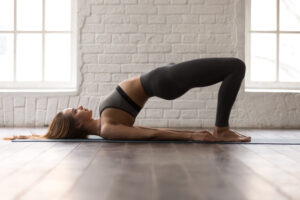 Yoga is not only relaxing but good for your body. It can help to promote a healthy spine and relieve back pain. For someone who is just getting started with yoga, it is recommended to start with simpler poses. Continue reading below for more information about yoga poses you can do if you experience back pain.
Yoga is not only relaxing but good for your body. It can help to promote a healthy spine and relieve back pain. For someone who is just getting started with yoga, it is recommended to start with simpler poses. Continue reading below for more information about yoga poses you can do if you experience back pain.
Yoga is a very popular and safe form of exercise. Many people think of yoga as just a good way to relieve stress and tension, but it can also help you reduce back pain and maintain a healthy spine. Yoga poses, called asanas, are important because they help stretch and strengthen important back muscles. Although there’s more to yoga than the postures—breath control and meditation are just as essential as poses are in yoga—this article highlights the benefits of doing yoga poses, including how they can prevent back pain.
The Goal of Yoga Poses
The goal of yoga poses isn’t about bending and forcing your body into certain positions—that could actually cause more back pain. Instead, yoga poses teach you proper alignment, such as how to maintain good posture. You may also become more flexible and be better able to maintain your balance.
When you do yoga poses—you can do them standing, sitting, and lying down—you should feel comfortable in them. But before getting to the more advanced poses, you have to practice the easier versions of the poses.
Think about it: If you’ve never trained for a marathon before, you wouldn’t just force your body into running 26.2 miles, would you? Why would you want to force your body into certain yoga poses if your body’s not ready for them?
Yoga Poses for Back Pain
Even the simple poses described below can help you reap the benefits of yoga. However, these poses and the number of times you do them every day are general guidelines for how to maintain a healthy spine. Talk to your doctor before incorporating these yoga poses into your routine.
Cat/Cow Stretch
- Start on all fours—on your hands and knees. Your hands and arms should be shoulder-distance apart and your knees should be hip-distance apart.
- Inhale, and then as you exhale, slowly start to draw your navel toward your spine and gently tuck your tailbone.
- As you inhale again, repeat the pose. Be sure to link your breath to your movement.
- Repeat the cat/cow stretch 5 to 10 times once a day.
Standing Forward Fold
- Start in a standing position with your feet hip-distance apart.
- As you inhale, raise both of your arms out to the side and then up so they’re above your head. Palms should be facing each other but not touching.
- As you exhale, slowly start to bend at the waist, and gently lower your arms out to the side and then down toward the ground if your hands can reach it. If not, then rest your hands on your shins.
- Let your head drop, and relax the neck. Notice your breath in the pose: Your breath should be steady and smooth. Hold this pose for 5 breaths.
- To come out of the pose, bend your knees slightly. Put your hands on your hips, and slowly start to come up, vertebra by vertebra. Let your head be the last to come up.
- Repeat standing forward fold 3 to 5 times once a day.
Bridge Pose
- Start by lying on your back with your feet flat on the floor and your knees bent. Your feet should be hip-distance apart.
- With your arms straight by the sides of your body and your palms on the ground, slowly start to lift your hips off the floor. Hold this for 3 seconds.
- Slowly roll back down to the floor, vertebra by vertebra.
- Repeat the bridge pose 3 times once a day.
In addition, with back pain, your abdominal muscles may be weak, so while it’s important to choose yoga poses that lengthen and strengthen your spine, you should also do poses that develop strong abdominals, such as opposite hands and knees balance.
Opposite Hands and Knees Balance
- Start off on your hands and knees. Without moving anything else, raise the right arm and left leg up about as high as your hips. Your hips, right arm, and left leg should be parallel to the floor. Keep the right arm and left leg straight.
- Your right hand should face the floor, and the toes of the left foot should face the floor. Hold this pose for 3 breaths. Then release. Repeat by raising your left arm and right leg.
- Repeat this pose 3 times on both sides once a day.
Other Benefits of Yoga Poses
Yoga poses can also help you build strength and flexibility, which can ultimately help alleviate your back pain. In fact, a study on the effect of Iyengar yoga (a type of yoga) therapy for chronic low back pain showed that patients experienced less back pain after doing Iyengar yoga for at least an hour and a half every week for 16 weeks and an at-home practice for 30 minutes 5 days a week.1
Keep in mind that after doing yoga, you may feel a little sore the next day, but that’s normal. Soreness should go away within a few days. Doing yoga poses should never cause pain, numbness, or tingling. If you feel any of these symptoms, stop immediately and call your doctor.
Bringing Yoga to You
Many yoga classes are offered at gyms, yoga studios, and community colleges. There are also many yoga DVDs available—some even give detailed instructions on poses that can decrease back pain.
You can also work with a private yoga instructor. He or she can give you individualized attention and coach you through certain yoga poses that can build back and core strength.
Because it’s a type of physical activity, talk to your doctor about doing yoga. For maximum back pain relief, you may need to combine yoga with other back pain treatments, such as medication or another form of exercise.
Original article posted on spineuniverse.com







